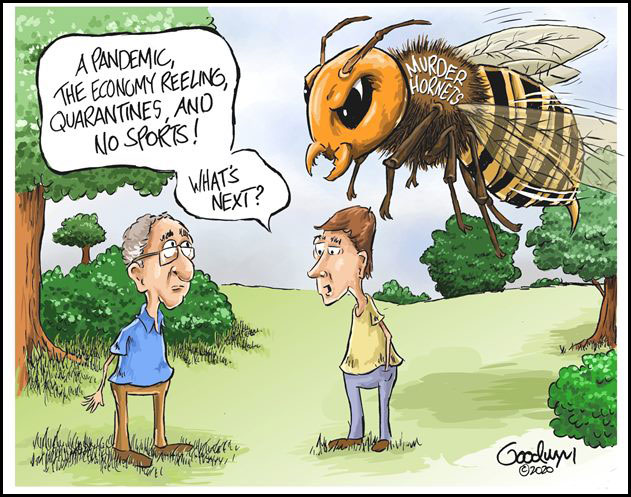print Print Cartoon
Questions
1. Cartoonists often use humor to illustrate a news item. What recent news item is cartoonist Al Goodwyn illustrating in this cartoon?
2. A cartoonist often uses humor to illustrate a news item. What comic device does the cartoonist use to illustrate this news story? Explain your answer.
a) caricature
b) personification
c) symbol
d) understatement
e) hyperbole
3. Info about murder hornets from the Washington State Department of Agriculture and Washington State University, as reported by Mashable:
- Asian giant hornets (murder hornets) are the largest species of hornet in the world. (They are 1.5 inches to more than 2 inches long.)
- Not only are Asian giant hornet stingers long enough to sting through normal beekeeper suits, getting stung by one of these hornets will cause excruciating pain.
- They can kill humans, but it’s rare: If people are allergic to the venom of Asian giant hornets or are stung by multiple hornets, it can be fatal. About 50 people are killed by the giant hornets each year in Japan, according to the Times.
- The hornets are territorial and will be aggressive when something gets close to their nest but are not as aggressive far away from their homes.
- Murder hornets kill entire bee colonies. This is the reason why they are referred to as murder hornets. [They threaten honey bee hives and the concern is that they could decimate the honeybee population.]
- Murder hornets are not invincible: Not only can humans do a lot to get rid of these pests, sometimes honeybees can outnumber these giant killers, and a bunch of honeybees will completely cover the murder hornets and kill them.
- Wikipedia notes: the hornet is native to temperate and tropical East Asia, South Asia, Mainland Southeast Asia, parts of the Russian Far East, though it is most common in rural areas of Japan. CNN reports it is not known how they arrived in the U.S.
The anchor of a CBS News report on the hornets said they “have a venomous sting that can kill someone if they are stung several times”
An AccuWeather headline reads: Terrifying ‘murder hornets’ invade US
Fear-mongering is defined as: The action of deliberately arousing public fear or alarm about a particular issue. Do you think the above are examples of the media using fear-mongering? Explain your answer.
Scroll down to the bottom of the page for the answers.

Cartoon by Al Goodwyn
Answers
1. This cartoon refers to reports that for the first time, Asian giant hornets (aka “murder hornets”) have been spotted in the U.S., specifically in Washington state.
2. e) hyperbole: Hyperbole is an exaggerated boast, character, situation, or environment. It stretches the truth well beyond reality. The key to good hyperbole is the tone; it has to be clear to the audience that it’s an exaggeration for comedic effect. The cartoonist uses hyperbole to exaggerate the size of the murder hornets (which are the world’s largest hornets), as well as the danger posed to humans by these hornets. (They can kill humans, but it’s rare.)
The cartoonist did not use:
a) caricature: A description or characterization that exaggerates or distorts a character’s prominent features, usually for purposes of mockery. For example, a cartoon of a gaunt Abraham Lincoln with a giant top hat, a very scraggly beard, and sunken eyes could be considered a caricature.
b) personification: when human characteristics are given to animals or inanimate objects
c) symbol: An object, character, figure, place, or color used to represent an abstract idea or concept. (For example: Uncle Sam represents the U.S. government)
d) understatement: a figure of speech (in this case an illustration) employed by writers or speakers (or cartoonists) to intentionally make a situation seem less important than it really is.
3. Opinion question. Answers vary.



